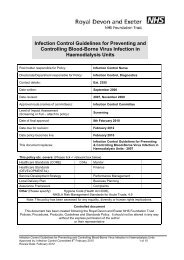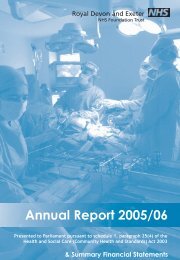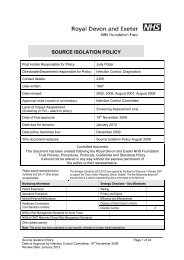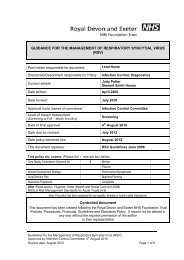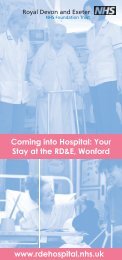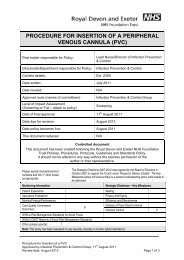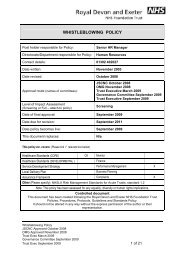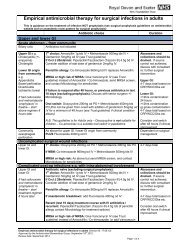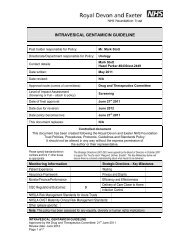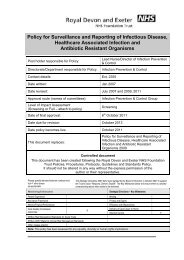Professional Lines Of Accountability For Non-Medical Regulated ...
Professional Lines Of Accountability For Non-Medical Regulated ...
Professional Lines Of Accountability For Non-Medical Regulated ...
Create successful ePaper yourself
Turn your PDF publications into a flip-book with our unique Google optimized e-Paper software.
Board of Directors MeetingDate: 25 July 2007Agenda item:9.3 Part ITitle: <strong>Professional</strong> <strong>Lines</strong> of <strong>Accountability</strong> for <strong>Non</strong> –<strong>Medical</strong> <strong>Regulated</strong> <strong>Professional</strong>sPrepared by: Marie-Noelle OrzelDirector of Nursing & Service ImprovementPresented by: Marie-Noelle OrzelDirector of Nursing & Service ImprovementAction required: To agree proposalMonitoring InformationPlease specify HC standard numbers andtick other boxes as appropriateHealthcare Standards – COREHealthcare Standards – DEVELOPMENTALMonitorService Development StrategyLocal Delivery PlanAssurance FrameworkStandardnumbersStandardnumbersC5bFinancePerformance ManagementBusiness PlanningComplaintsEquality, diversity, human rights implications assessedxOther (please specify)Title of Paper: <strong>Lines</strong> of <strong>Accountability</strong> for non-medical professionalsBoard Date: 25 July 2007
1. PURPOSE1.1 In April 2007 the board was apprised of proposed changes to the regulation of healthprofessionals as outlined in the recently published White Paper ‘Trust, Assurance andSafety – The Regulation of Health <strong>Professional</strong>s in the 21 st Century’. The paperproposed that a scoping exercise of all the non-medical professional roles workingwithin the RD&E to ensure that there are robust lines of professional accountability.This paper considers the current position in the RD&E and recommends professionalreporting lines for the future.2. BACKGROUND2.1 Within the RD&E there are a number of non-medical professional groups (SeeAppendix 1). Over the last few years a number of new regulated non-medicalregulated professional bodies have emerged, the most significant of these beingOperating Department Practitioners (ODP) who were regulated by the HPC in 2004.In addition the recently published White Paper ‘Trust, Assurance and Safety – TheRegulation of Health <strong>Professional</strong>s in the 21 st Century’, has highlighted the need toscope the range of non-medical regulated professional groups working within theRD&E to ensure there are effective reporting lines for management and professionalaccountability.3. KEY ISSUES3.1 From a governance perspective it is important that the RD&E has a nominated seniorindividual who takes professional accountability and responsibility for each of thenationally regulated professional groups. Currently there are clear management linesof accountability through individual Directorate management structures. As a result ofnewly regulated professional groups and historical reporting lines there are a numberof non-medical regulated professional groups who have no clearly defined seniorprofessional reporting line of accountability.4. PROPOSALS4.1 The Director of Nursing & Service Improvement maintains professional responsibilityfor nurses and midwives, whilst taking on the professional line of accountability forODPs. In addition she will take responsibility for requesting the issue of an alert letterfor any member of staff who is regulated with either the Nursing & Midwifery Councilor Health <strong>Professional</strong> Council.4.2 The Clinical Director for <strong>Professional</strong> Services take professional responsibility andaccountability for all other nationally regulated non-medical professional groupsworking within the RD&E and/or are likely to be regulated in the near future5. FINANCIAL/OTHER IMPLICATIONSNil6. RECOMMENDATIONSTo accept the proposed lines of professional accountability for each of the nonmedicalregulated professional groups.Title of Paper: <strong>Lines</strong> of <strong>Accountability</strong> for non-medical professionalsBoard Date: 25 July 2007
APPENDIX 1PROFESSIONAL LINES OF ACCOUNTABILITY FOR NON-MEDICAL REGULATEDPROFESSIONSBackgroundWithin the Royal Devon & Exeter NHS Foundation Trust (RD&E) there are a number ofdifferent non-medical professional groups. The largest group are nurses and midwiveswhose professional line of accountability is to the Director of Nursing & Service Improvementand to the Nursing & Midwifery Council (NMC). There are also a number of other regulatedprofessional groups including the allied health professionals (AHP) (see Fig 1). To date, theClinical Director for professional services has maintained the professional line ofaccountability for most of this group of staff who are regulated by the Health <strong>Professional</strong>Council (HPC) and sit within the <strong>Professional</strong> Services Directorate.Over the last few years a number of new regulated non-medical regulated professionalbodies have emerged, the most significant of these being Operating DepartmentPractitioners (ODP) who were regulated by the HPC in 2004. In addition the recentlypublished White Paper ‘Trust, Assurance and Safety – The Regulation of Health<strong>Professional</strong>s in the 21 st Century’, has highlighted the need to scope the range of nonmedicalregulated professional groups working within the RD&E to ensure there are effectivereporting lines for management and professional accountability. This paper considers thecurrent position in the RD&E and recommends professional reporting lines for the future.Current positionDirector of Nursing & Service ImprovementAll nurses & midwives are managed through their directorate management structures withprofessional accountability through the senior nursing and midwifery structure. The Directorof Nursing & Service Improvement has the executive responsibility for the nursing &midwifery workforce and practice.Clinical Director <strong>Professional</strong> ServicesThere are a number of non-medical professional groups that are managed through theirdirectorate management structure with professional accountability through to the ClinicalDirector for <strong>Professional</strong> Services. These include:Chiropodists/PodiatristsDieticiansOccupational TherapistsPhysiotherapistsProsthetists & OrthotistsArt TherapistsSpeech and language therapistsPharmacists (not currently regulated)Healthcare (Clinical) Scientists (only those who sit in <strong>Professional</strong> services)Title of Paper: <strong>Lines</strong> of <strong>Accountability</strong> for non-medical professionalsBoard Date: 25 July 2007
Other non-medical regulated professional groupsThere are a number of non-medical regulated professional groups that currently have noagreed professional line of accountability. They are managed through the relevantdirectorate management structures and professional issues will currently be addressedwithin their own team structures. These include:Operating Department PractitionersBiomedical ScientistsOrthoptistsRadiographersFuture positionThere are a number of aspirant professional groups who are seeking national registrationand regulation (fig 2). A number of these are employed within the RD&E and include:• Cardiac Physiologists (A sector of the Council for Clinical Physiologists and likely toregister with the HPC soon)• Neurophysiologists (as above)• Counsellors• Mortuary technicians• Retinal ScreenersIn addition the NMC and HPC are considering a separate registration for advancedpractitioners although it is thought that this will be via their current professional bodies.ProposalFrom a governance perspective it is important that the RD&E has a nominated seniorindividual who takes professional accountability and responsibility for each of the nationalregulated professions. It is therefore proposed that:a) The Director of Nursing & Service Improvement has professional responsibility andaccountability for nurses, midwives and ODPs. In addition she will take responsibilityfor requesting the issue of an alert letter for and member of staff who is regulatedwith either the NMC or HPC (current regulations stipulate that it must be anExecutive Director that signs of the request for issue of an alert letter).b) The Clinical Director for <strong>Professional</strong> Services has professional responsibility andaccountability for all other nationally regulated non-medical professional groupsworking within the RD&E and/or are likely to be regulated in the near futureNext stepsIf the above proposal is agreed then appropriate guidance will be issued to DirectorateMangers who will be required to update individual job descriptions to reflect the appropriateline of professional accountability.M OrzelDirector of Nursing & Service ImprovementJuly 2007Title of Paper: <strong>Lines</strong> of <strong>Accountability</strong> for non-medical professionalsBoard Date: 25 July 2007
Register – Number of Registrants...Fig 1.45,00040,00035,00030,00025,00020,00015,00010,0005,0000177,000 registrants,13 ProfessionsPhysiotherapistsOccupational TherapistsRadiographersBiomedical ScientistsParamedicsChiropodistsS<ODPDietitiansClinical ScientistsArts TherapistsOrthoptistsProsthetists & OrthotistsRef:HPC/MJS/DoH/June 2007Fig 2.Aspirant Groups• Number of professions not restricted• Dozens of Aspirant Groups‣ Operating Department Practitioners 7,500 (10/04)‣ Applied Psychologists 15,000‣ Health Care Scientists17,500 Est‣ <strong>Medical</strong> Illustrators 400‣ Clinical Perfusionists 300‣ Clinical Physiologists 5,000‣ Clinical Technologists 5,000‣ Max Fax 400‣ Dance Movement Therapists 300Title of Paper: <strong>Lines</strong> of <strong>Accountability</strong> for non-medical professionalsBoard Date: 25 July 2007



